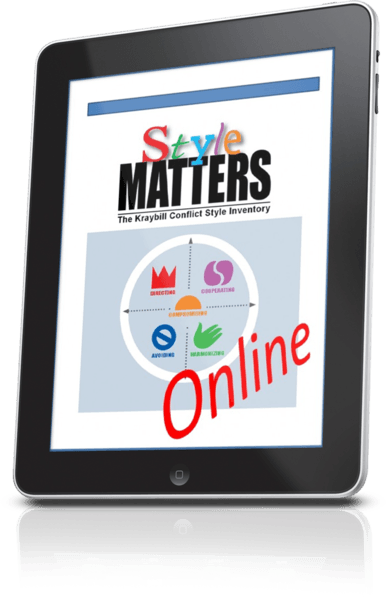Life spares none from conflict.
But unfortunately the word has not yet reached the schools that train professionals.
 taking Style Matters Online. Instruct them to read their score report carefully and spend, say, 20 minutes clicking links in the report to resources that interest them on the Riverhouse website. (These include a tutorial, summaries of strengths and weaknesses of each style, essays on anger management, apology, conflict and culture, and much more.) Pick out an exercise from the ideas below and assign it to your students to do on their own. I invite you to adapt and present them as your own.
taking Style Matters Online. Instruct them to read their score report carefully and spend, say, 20 minutes clicking links in the report to resources that interest them on the Riverhouse website. (These include a tutorial, summaries of strengths and weaknesses of each style, essays on anger management, apology, conflict and culture, and much more.) Pick out an exercise from the ideas below and assign it to your students to do on their own. I invite you to adapt and present them as your own.Assignment: Write a Reflection Paper
-
When you are in Calm conditions, that is, when differences have just surfaced and emotions are not yet high, which conflict style or styles are you most likely to use? What are the strengths of this style or styles? What are the dangers of over-using this style?
-
When you are in Storm conditions, that is, when previous efforts to resolve a conflict haven’t worked and emotions have escalated, which conflict style or styles are you most likely to use? What are the strengths of this style or styles? What are the dangers of over-using it?
-
Drawing on the feedback in the score report and/or your own reflections, what do you see as personal growth areas for yourself in improving your conflict management abilities?
An additional task you could add to that list is to have students discuss their score report with someone who knows them well. The assignment could read: Discuss your score report with someone who knows you well and whom you trust – a family member, friend, or colleague. Invite this person to comment from their general observations of you. Using the report as a resource, what do they see as your strengths in conflict? What do they think might be “growing edges” for you in strengthening your responses to conflict? Summarize your learnings in the essay.
Assignment: Apply Conflict Styles Framework to a Personal Conflict
- Which conflict style or styles did you use? Did this change over time? If so, why, and how did this change in style alter the dynamics of the conflict?
- Do you see in retrospect that you under-used or over-used certain styles?
- Are there any tips (see the list of Support strategies suggested for your high-scoring Storm styles in the report) that, if the other person had followed, might have assisted you to function better?
- Choose another person who was central in this conflict and comment: What style or styles was this person primarily using? How did you respond to this style? Can you offer any tips for yourself (based on this experience and/or what you’ve learned about conflict styles) about what to do or not to do that might enable you to achieve a better outcome with this conflict style in the future?
Assignment: Discuss Conflict Styles in Study Group or Work Team
-
My Calm style of dealing with conflict is….. Benefits of this style for me are…. Benefits for others when I use it are…. Dangers or costs of overusing this style are……..
-
My Storm style of dealing with conflict is…. Benefits of this style for me are…. Benefits for others when I use it are…. Dangers or costs of overusing this style are……..
-
Things that others around me can do when there is conflict that will meet my conflict style preferences and make it easier for me to function at my best are….. (As a resource for this, review the sections of the report titled “Support Strategies”)
-
Something useful I’ve learned from our discussion here about how others function in conflict is that……
* * * * * * * *
 I would love to hear your ideas for effective learning experiences outside of the classroom! Please send them to me at center@riverhouseepress.com. With your permission, I’ll publish the best ones here.
I would love to hear your ideas for effective learning experiences outside of the classroom! Please send them to me at center@riverhouseepress.com. With your permission, I’ll publish the best ones here.
For discussion questions and exercises in workshop settings, see my essay, Suggestions for Reflection and Learning with Others About Conflict Styles. And of course you’ll find detailed guidance on leading a workshop – if you decide to go that route – in my free downloads “Trainers Guide to Successful Conflict Styles Workshops and Training with Style Matters Online Version.
By Ron Kraybill, author of the Style Matters conflict style inventory and a blog KraybillTable.com. You may use or reproduce these exercises for classroom training purposes but all rights are reserved by the author. For publications, please contact the author for permission.


